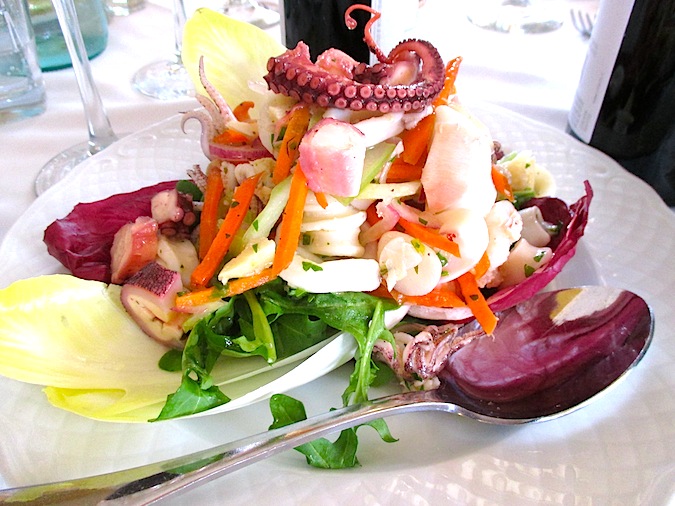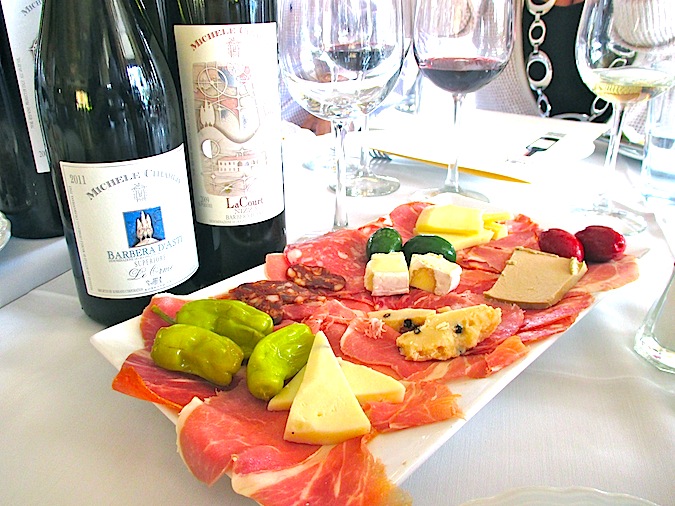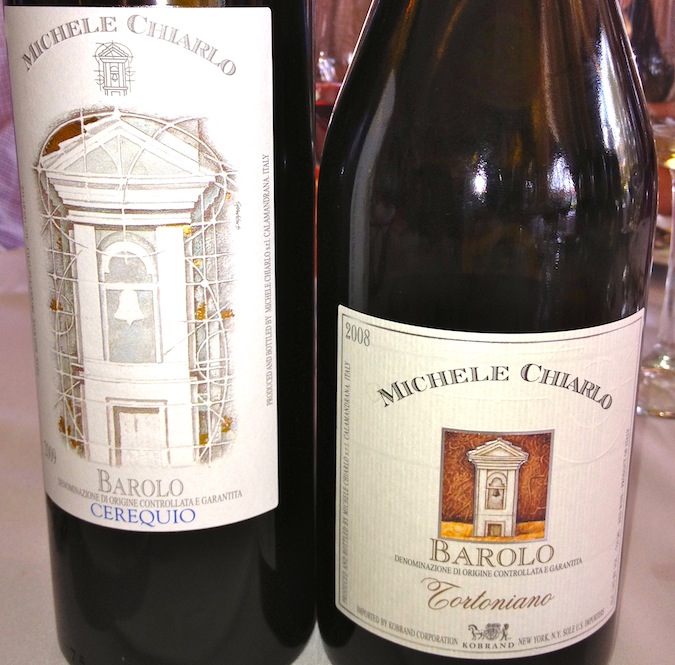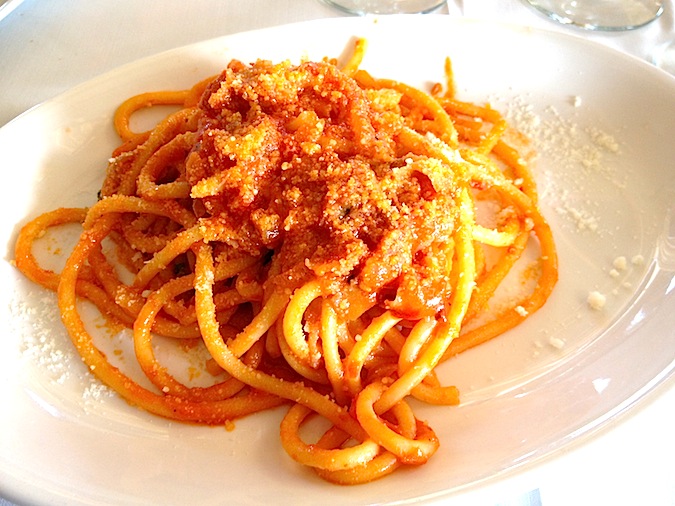
This week's Wine Word of the Week is "demi-sec" and was suggested by our fabulous Facebook Fan, Michelle Olson-Rogers - thanks for the suggestion, Michelle!Demi-sec is a French term which literally means "semi-dry" or "medium-dry" yet is used to refer to wines which are slightly to medium sweet. The term is usually used in association with wines from France's Champagne and Loire wine regions. In Champagne, the dosage, a mixture of wine and sugar added to the bottle following disgorgement, determines the final sweetness of the wine. So for a wine to be labelled as "demi-sec" the amount of sugar added can be anywhere from 35-50 g/l or 3.5-5% which is dictated by vinous law. The scale from driest to sweetest is (1) brut nature or sans dosage where no sugar is added, (2) extra brut, (3) brut, (4) extra dry, (5) sec, (6) demi-sec, and (7) doux which is the sweetest level. In the United States the different levels of sweetness do not have any legal definitions like they do in France.So next time you see a wine with "demi-sec" on the label, you know the wine in that bottle will be somewhat sweet. Oftentimes, especially with Champagne, the sweetness in the wine is balanced by a lovely acidity so the wine doesn't feel cloying on the palate. These delicious wines are perfect for serving with moderately sweet desserts and make an elegant addition to a dinner party.Thanks again for your suggestion, Michelle, and I hope that helps! If you’d like to suggest a word for our Wine Word of the Week segment please leave it in the comment section below or on our Facebook Fan Page which you can access by clicking here. If we use your word, your name will be entered into our monthly drawing to win one month of The Wine Atelier’s “Explorateur” Wine Club but remember - you have to play to win so make your suggestion now!Cheers,

This week’s Wine Word of the Week is “demi-sec” and was suggested by our fabulous Facebook Fan, Michelle Olson-Rogers – thanks for the suggestion, Michelle!
Demi-sec is a French term which literally means “semi-dry” or “medium-dry” yet is used to refer to wines which are slightly to medium sweet. The term is usually used in association with wines from France’s Champagne and Loire wine regions. In Champagne, the dosage, a mixture of wine and sugar added to the bottle following disgorgement, determines the final sweetness of the wine. So for a wine to be labelled as “demi-sec” the amount of sugar added can be anywhere from 35-50 g/l or 3.5-5% which is dictated by vinous law. The scale from driest to sweetest is (1) brut nature or sans dosage where no sugar is added, (2) extra brut, (3) brut, (4) extra dry, (5) sec, (6) demi-sec, and (7) doux which is the sweetest level. In the United States the different levels of sweetness do not have any legal definitions like they do in France.
So next time you see a wine with “demi-sec” on the label, you know the wine in that bottle will be somewhat sweet. Oftentimes, especially with Champagne, the sweetness in the wine is balanced by a lovely acidity so the wine doesn’t feel cloying on the palate. These delicious wines are perfect for serving with moderately sweet desserts and make an elegant addition to a dinner party.
Thanks again for your suggestion, Michelle, and I hope that helps! If you’d like to suggest a word for our Wine Word of the Week segment please leave it in the comment section below or on our Facebook Fan Page which you can access by clicking here. If we use your word, your name will be entered into our monthly drawing to win one month of The Wine Atelier’s “Explorateur” Wine Club but remember – you have to play to win so make your suggestion now!
Cheers,
![]()

Easter is fast approaching and with it my desire for light, refreshing wines that pair beautifully with the flavors of Spring. Here are some recommendations for wines that will pair perfectly with your Easter meal, from the rack of lamb to the Honey Baked Ham! These wines are moderate in regard to alcohol and tannin with a nice balance of fruit and will appeal to a variety of palates. This week only, enter the code “EASTER“at checkout (or mention it to us for phone orders) to receive $10 off your order of $100 or more.
 Cleto Chiarli Brut de Noir Rosé, Emilia-Romagna, Italy, NV ($16): Italian winemakers Franco De Biasio and Michele Faccin crafted this lightly sparkling wine from a blend of 85% Lambrusco Grasparossa and 15% Pinot Nero (aka Pinot Noir). Secondary fermentation (how the wine gets its bubbles) took place using the Charmat method resulting in a lightly sparkling wine with an inviting pale pink color. The nose has fragrant aromatics of red berries while on the palate flavors of raspberry, strawberry and citrus accompany a delightfully dry finish. This wine is an excellent aperitif and also pairs well with a variety of cuisines.
Cleto Chiarli Brut de Noir Rosé, Emilia-Romagna, Italy, NV ($16): Italian winemakers Franco De Biasio and Michele Faccin crafted this lightly sparkling wine from a blend of 85% Lambrusco Grasparossa and 15% Pinot Nero (aka Pinot Noir). Secondary fermentation (how the wine gets its bubbles) took place using the Charmat method resulting in a lightly sparkling wine with an inviting pale pink color. The nose has fragrant aromatics of red berries while on the palate flavors of raspberry, strawberry and citrus accompany a delightfully dry finish. This wine is an excellent aperitif and also pairs well with a variety of cuisines.
 Seven Hills Dry Rosé, Columbia Valley, Washington, 2013 ($16): 2013 is the first vintage of this delightful, dry rosé from Seven Hills winemaker Casey McLellan. It is based on specific vineyard blocks of Bordeaux varietals which are farmed specifically for this wine crafted in the style of classic French Provencal rosés. It is delicate and refreshing, pale in color, and bone-dry with flavors of peach, grapefruit, and papaya as well as fresh herbs, white flowers, and a hint of spice. Because it is a blend of 70% Cabernet Franc, 15% Petit Verdot and 15% Malbec it has lovely structure and presence as well – I like to call this wine the red wine drinker’s rosé!
Seven Hills Dry Rosé, Columbia Valley, Washington, 2013 ($16): 2013 is the first vintage of this delightful, dry rosé from Seven Hills winemaker Casey McLellan. It is based on specific vineyard blocks of Bordeaux varietals which are farmed specifically for this wine crafted in the style of classic French Provencal rosés. It is delicate and refreshing, pale in color, and bone-dry with flavors of peach, grapefruit, and papaya as well as fresh herbs, white flowers, and a hint of spice. Because it is a blend of 70% Cabernet Franc, 15% Petit Verdot and 15% Malbec it has lovely structure and presence as well – I like to call this wine the red wine drinker’s rosé!
 “the girls in the vineyard” Sauvignon Blanc, California, 2013 ($15): These grapes hail from the Rooster Vineyard in Lake County located one hour north of the Napa Valley. The grapes grow on the gravelly soils of an ancient riverbed which sits 1,350 feet above sea level and experiences gloriously warm days, followed by pleasantly cool nights. On the nose, aromas of peach and citrus set your tastebuds humming while on the palate, crisp, fresh notes of lemon zest, ripe peach and pear finish with a hint of lemongrass. This wine is fermented entirely in stainless steel to preserve its crisp, fresh fruit flavors and makes for a very versatile partner at the table.
“the girls in the vineyard” Sauvignon Blanc, California, 2013 ($15): These grapes hail from the Rooster Vineyard in Lake County located one hour north of the Napa Valley. The grapes grow on the gravelly soils of an ancient riverbed which sits 1,350 feet above sea level and experiences gloriously warm days, followed by pleasantly cool nights. On the nose, aromas of peach and citrus set your tastebuds humming while on the palate, crisp, fresh notes of lemon zest, ripe peach and pear finish with a hint of lemongrass. This wine is fermented entirely in stainless steel to preserve its crisp, fresh fruit flavors and makes for a very versatile partner at the table.
![]() Feudo Maccari Nero d’Avola, Sicily, Italy, 2011 ($17): Just over a mile from the sea on the southern tip of Sicily, Feudo Maccari was established in 2000. The estate is assembled from more than fifty separate plots of land, which translates to more complexity in their portfolio of wines. This wine is made from 100% Nero d’Avola grapes fermented in stainless steel tank to preserve the fresh fruit aromas and flavors. It has a deep purple color and exhibits inviting aromas of red fruit and spice. The palate rewards with savory flavors of black cherry, licorice and a hint of tobacco framed by just the right amount of acid and tannin.
Feudo Maccari Nero d’Avola, Sicily, Italy, 2011 ($17): Just over a mile from the sea on the southern tip of Sicily, Feudo Maccari was established in 2000. The estate is assembled from more than fifty separate plots of land, which translates to more complexity in their portfolio of wines. This wine is made from 100% Nero d’Avola grapes fermented in stainless steel tank to preserve the fresh fruit aromas and flavors. It has a deep purple color and exhibits inviting aromas of red fruit and spice. The palate rewards with savory flavors of black cherry, licorice and a hint of tobacco framed by just the right amount of acid and tannin.
 Charles Joguet Chinon Cuvée Terroir, Loire, France, 2011 ($24): Hailing from the heart of France’s Loire Valley, this “cuvée” is crafted from 100% Cabernet Franc grapes from the thirty year old vines of Beaumont-en-Véron. The sandy and alluvial vineyard soils offer fruity and supple wines meant to be consumed in their youth. This medium-bodied red is perfect for Spring with fragrant aromatics of red and black fruit and flavors of cherry, damson plum and pomegranate. As is characteristic of the red wines of this region, it also has a bright, food-friendly acidity that will make a delicious accompaniment for your savory Easter lamb.
Charles Joguet Chinon Cuvée Terroir, Loire, France, 2011 ($24): Hailing from the heart of France’s Loire Valley, this “cuvée” is crafted from 100% Cabernet Franc grapes from the thirty year old vines of Beaumont-en-Véron. The sandy and alluvial vineyard soils offer fruity and supple wines meant to be consumed in their youth. This medium-bodied red is perfect for Spring with fragrant aromatics of red and black fruit and flavors of cherry, damson plum and pomegranate. As is characteristic of the red wines of this region, it also has a bright, food-friendly acidity that will make a delicious accompaniment for your savory Easter lamb.
![]() Copain Tous Ensemble Pinot Noir, Anderson Valley, CA, 2010 ($26): Crafted by winemaker Wells Guthrie, this wine is an embodiment of the earthy, sweet beet root undertones that are indicative of Anderson Valley Pinot Noir. Guthrie takes his inspiration for Pinot Noir from the great wines of Burgundy and aims to create wines of elegance and balance. This medium-bodied wine has vibrant dark red fruit on the nose and palate and delivers pure, focused flavors with a great lift on the finish from the acidity. The 2010 vintage resulted in wines which are incredibly elegant and offer great tension and balance.
Copain Tous Ensemble Pinot Noir, Anderson Valley, CA, 2010 ($26): Crafted by winemaker Wells Guthrie, this wine is an embodiment of the earthy, sweet beet root undertones that are indicative of Anderson Valley Pinot Noir. Guthrie takes his inspiration for Pinot Noir from the great wines of Burgundy and aims to create wines of elegance and balance. This medium-bodied wine has vibrant dark red fruit on the nose and palate and delivers pure, focused flavors with a great lift on the finish from the acidity. The 2010 vintage resulted in wines which are incredibly elegant and offer great tension and balance.
All of our Easter selections are available through The Wine Atelier (click here to view these wines in our wine boutique) and, as always, we offer 3 convenient ways to receive your wines, (1) pickup at our location at 900 E. Atlantic Avenue Suite #13, Delray Beach, FL 33483 (by appointment); (2) local delivery in the Boca Raton/Delray Beach area for orders $250 and (3) shipping via UPS. Please call us at 561.317.6663 with any questions and have a very Happy Easter!
Cheers,
![]()

Spring has finally sprung, serving as our seasonal indicator that it’s time to switch from those comforting winter dishes to lighter, more figure friendly fare.
Here in South Florida, it may come as no surprise that citrus plays a large role in our springtime cuisine. Many of our citrus fruits are sourced locally so when I came across this recipe for Thai Pomelo Salad (Dtam Som Oo) in the March 2014 issue of Saveur Magazine, it peaked my interest since it incorporated the delicious and exotic pomelo. Also known as shaddock, pummelo, Chinese grapefruit, or lusho fruit, the pomelo is native to Southeast Asia and is the largest known citrus fruit. It is a principal ancestor of the grapefruit and over the years, was introduced to North America where it is now grown in many states including Texas, California, Arizona and Florida. The large fruit (pictured bottom right) tastes like a milder version of a grapefruit, which is slightly sweeter and not quite as acidic.

I wanted to make this recipe for dinner so I added a chicken breast that I pounded flat, seasoned with salt and pepper and grilled and then plated the chicken with the salad on top of it. The dressing is incredibly flavorful and gives this lighter dish plenty of delicious flavor and personality. In the event you are unable to locate a pomelo or if they are out of season, a ruby red grapefruit will work equally as well. Also, slicing a citrus fruit into “supremes” can take a little practice and involves separating the fruit into segments by removing the bitter peel, pith and membranes. For a video on how to perform this culinary technique from Iron Chef Michael Symon, please click here. I do recommend using a very sharp knife to supreme your citrus and once you complete that part of the prep, making the dressing and assembling the salad is a breeze!
To pair with the Thai Chicken and Pomelo Salad, I served the 2012 Château Pesquié Terrasses Blanc ($16) a blend of 70% Viognier, 15% Roussanne, and 15% Clairette grown in the limestone soils of France’s Southern Rhone Valley. This wine is delightfully fresh, floral and fruity with a bright acidity, notes of honeysuckle, white peach and pear with a mineral-tinged finish. Winemakers Alexandre and Frédéric Chaudière fermented the wine entirely in stainless steel and concrete vats to preserve its fresh fruit aromas and flavors which complement the flavors of the dish beautifully!
Cheers,
![]()
Thai Chicken & Pomelo Salad
1/4 cup Thai fish sauce
2 Tbsp. sugar
1 Tbsp. fresh lime juice
1-2 Pomelos depending on size (2 grapefruit), peeled and supremed
2 fresh red Thai chiles
1 clove garlic, finely chopped
1 cup trimmed watercress
1/3 cup roughly chopped peanuts, lightly toasted
20 fresh mint leaves
4 boneless, skinless chicken breasts, pounded thin
Drizzle chicken breasts on both sides with olive oil and then season with salt and pepper. Preheat a grill pan or outdoor grill to medium-high heat and lightly brush grates with olive oil. Cook the chicken breasts approximately 3-4 minutes per side until done and set aside. Whisk fish sauce, sugar, lime juice, chiles, garlic, and 1/4 cup water in a bowl and set aside. Plate chicken and top with the watercress. Scatter pomelo or grapefruit sections over the salad, spoon on the dressing and top with the chopped peanuts and mint leaves. Serves 4

This week's Wine Word of the Week is "fining" and was suggested to us by our fabulous Facebook fan, Joan Axthelm - thanks for the suggestion, Joan!Fining is a winemaking technique which removes microscopic particles and chemicals from a wine which can adversely affect its color, aroma and/or flavor. Fining agents such as bentonite, egg whites and gelatin are added to wine and act like a magnet, bonding with the undesirable components, which can include excessive tannins, microscopic particulate matter and/or other pesky chemicals. Once bonded, they precipitate out of solution and are removed, leaving the wine more chemically stable and less likely to spoil over time.Fining is often used in the same sentence as "filtration," as the two often go hand in hand. Whereas fining binds to particles or chemicals in order to remove them, filtration involves passing the wine through a physical filter, filtering out anything larger than the pores of the barrier. Filtration removes harmful compounds including yeast (i.e Brettanomyces) and/or bacteria (i.e. malolactic bacteria) through filtration mediums including cellulose fiber pads, diatomaceous earth, and perlite.It is important to note that while there are many advantages of using these techniques, not the least of which is making a wine more suitable for the aging process, one of the disadvantages of fining and filtration is that they can strip a wine of desirable flavor and/or aroma compounds. For this reason, many winemakers who bottle their wines "unfiltered and unfined," promote them as being superior to those that are. Unfortunately this factor alone does not guarantee a wine's quality - what good is a wine with more nuanced aromas and flavors if it has been spoiled by the ravages of Brettanomyces? The fact is, there are quality wines in both categories so it's best to let your palate be the final determiner of a wine's quality.Thanks again for your suggestion, Joan and if you'd like to suggest a word for our Wine Word of the Week segment please leave it in the comment section below or on The Glamorous Gourmet & Wine Atelier Facebook Fan Page which you can access by clicking here. If we use your word, your name will be entered into our monthly drawing to win one month of The Wine Atelier's "Explorateur" Wine Club but remember, you have to play to win!Cheers,

This week’s Wine Word of the Week is “fining” and was suggested to us by our fabulous Facebook fan, Joan Axthelm – thanks for the suggestion, Joan!
Fining is a winemaking technique which removes microscopic particles and chemicals from a wine which can adversely affect its color, aroma and/or flavor. Fining agents such as bentonite, egg whites and gelatin are added to wine and act like a magnet, bonding with the undesirable components, which can include excessive tannins, microscopic particulate matter and/or other pesky chemicals. Once bonded, they precipitate out of solution and are removed, leaving the wine more chemically stable and less likely to spoil over time.
Fining is often used in the same sentence as “filtration,” as the two often go hand in hand. Whereas fining binds to particles or chemicals in order to remove them, filtration involves passing the wine through a physical filter, filtering out anything larger than the pores of the barrier. Filtration removes harmful compounds including yeast (i.e Brettanomyces) and/or bacteria (i.e. malolactic bacteria) through filtration mediums including cellulose fiber pads, diatomaceous earth, and perlite.
It is important to note that while there are many advantages of using these techniques, not the least of which is making a wine more suitable for the aging process, one of the disadvantages of fining and filtration is that they can strip a wine of desirable flavor and/or aroma compounds. For this reason, many winemakers who bottle their wines “unfiltered and unfined,” promote them as being superior to those that are. Unfortunately this factor alone does not guarantee a wine’s quality – what good is a wine with more nuanced aromas and flavors if it has been spoiled by the ravages of Brettanomyces? The fact is, there are quality wines in both categories so it’s best to let your palate be the final determiner of a wine’s quality.
Thanks again for your suggestion, Joan and if you’d like to suggest a word for our Wine Word of the Week segment please leave it in the comment section below or on The Glamorous Gourmet & Wine Atelier Facebook Fan Page which you can access by clicking here. If we use your word, your name will be entered into our monthly drawing to win one month of The Wine Atelier’s “Explorateur” Wine Club but remember, you have to play to win!
Cheers,
![]()
I recently had the pleasure of meeting Alberto Chiarlo, son of Michele who established the family's eponymous winery in Italy's renowned Piedmont region in 1956. The Michele Chiarlo wines represent this family's dedication to the mastery and expression of Piemontese terroir through the use of indigenous grape varieties, innovative viticultural practices and seven generations of winemaking tradition.We met at Piattini, a new Italian eatery in Boca Raton's Royal Palm Place, whose deliciously authentic cuisine provided the perfect accompaniment for the featured wines. As we took our seats Chiarlo explained, "We make wine to go with food," reinforcing one of my favorite things about Italian wine, "and Piemonte is the food capital." With just shy of 20 Michelin-starred restaurants in the region, he made an excellent point. We began the tasting with the 2012 Michele Chiarlo Gavi "Le Marne," a delightful white wine made from 100% Cortese grapes with inviting aromas of white flowers, citrus and minerals. Chiarlo explained, "Our goal is to make wines that are expressive of the soil, [they are] not super modern." Stefano Chiarlo, Alberto's brother and Chiarlo winemaker, generally abstains from the use of temperature controlled fermentation and new French oak." [We are] traditionalists and use the same style now as my grandfather. Our wines are grown in the field...the less touch in winemaking, the better." This bright white wine had flavors of white peach and lemon accompanied by a crisp acidity which paired deliciously with the freshly grilled octopus.Of all their wines, Barbera is most definitely at the heart of the Michele Chiarlo ethos. This might sound surprising in the context of this region which deifies the Nebbiolo grape and has historically considered Barbera a one-dimensional wine more suitable for everyday enjoyment. However, Barbera was essentially the first wine the Chiarlo family produced and over the years they've done much to elevate its reputation. "Our first goal is to make Barbera," Chiarlo stated with conviction. In order to produce the finest incarnation of this grape, the winemaking team implements green harvesting, a technique first introduced to the region by Michele Chiarlo in which the fruit of the vigorous Barbera vines is dramatically thinned, resulting in fewer grapes of higher quality with the goal of creating a more complex and potentially age-worthy wine.Since Barbera plantings must vie for land with Nebbiolo in the town of Alba, another region known for producing much of Piedmont's Barbera wines, Barbera from Asti is generally considered more structured and complex due to the availability of superior vineyard land. The 2011 Michele Chiarlo Barbera d'Asti Superiore "Le Orme," is made from fruit sourced in the southern part of Asti from the hills around Nizza Monferrato. The wine is fermented for ten days in stainless steel tanks and then aged for eight months in large French oak casks prior to release. The wine had enticing aromas and flavors of black fruit, cassis and spice as well as a lovely hint of violet. On the palate, the wine had a velvety mouthfeel while the acid and tannin struck a harmonious balance. This wine was perfect for enjoying on its own but also paired extremely well with the flavors of the Prosciutto di Parma and decadent duck pate.
We began the tasting with the 2012 Michele Chiarlo Gavi "Le Marne," a delightful white wine made from 100% Cortese grapes with inviting aromas of white flowers, citrus and minerals. Chiarlo explained, "Our goal is to make wines that are expressive of the soil, [they are] not super modern." Stefano Chiarlo, Alberto's brother and Chiarlo winemaker, generally abstains from the use of temperature controlled fermentation and new French oak." [We are] traditionalists and use the same style now as my grandfather. Our wines are grown in the field...the less touch in winemaking, the better." This bright white wine had flavors of white peach and lemon accompanied by a crisp acidity which paired deliciously with the freshly grilled octopus.Of all their wines, Barbera is most definitely at the heart of the Michele Chiarlo ethos. This might sound surprising in the context of this region which deifies the Nebbiolo grape and has historically considered Barbera a one-dimensional wine more suitable for everyday enjoyment. However, Barbera was essentially the first wine the Chiarlo family produced and over the years they've done much to elevate its reputation. "Our first goal is to make Barbera," Chiarlo stated with conviction. In order to produce the finest incarnation of this grape, the winemaking team implements green harvesting, a technique first introduced to the region by Michele Chiarlo in which the fruit of the vigorous Barbera vines is dramatically thinned, resulting in fewer grapes of higher quality with the goal of creating a more complex and potentially age-worthy wine.Since Barbera plantings must vie for land with Nebbiolo in the town of Alba, another region known for producing much of Piedmont's Barbera wines, Barbera from Asti is generally considered more structured and complex due to the availability of superior vineyard land. The 2011 Michele Chiarlo Barbera d'Asti Superiore "Le Orme," is made from fruit sourced in the southern part of Asti from the hills around Nizza Monferrato. The wine is fermented for ten days in stainless steel tanks and then aged for eight months in large French oak casks prior to release. The wine had enticing aromas and flavors of black fruit, cassis and spice as well as a lovely hint of violet. On the palate, the wine had a velvety mouthfeel while the acid and tannin struck a harmonious balance. This wine was perfect for enjoying on its own but also paired extremely well with the flavors of the Prosciutto di Parma and decadent duck pate. In addition to the "Le Orme," we also sampled the 2009 Barbera d'Asti Superiore Nizza "La Court," Michele Chiarlo's single vineyard Barbera made from fifty year old vines and only in the best vintages. Again, Chiarlo stressed the wine was, "very traditional, [fermented in] open vats with no temperature control. In order to do this we must have perfect grapes." Fermentation in large oak casks was followed by an additional twelve months of oak aging resulting in a wine with structure and balance as well as heady aromas and flavors of ripe cherry, plum and spice with a tangy acidity and lengthy finish. This wine is delicious now but will continue to benefit from and evolve with additional time in the bottle. The "La Court" synergized deliciously with the Aged Goat Cheese studded with heavenly bits of Black Truffle.
In addition to the "Le Orme," we also sampled the 2009 Barbera d'Asti Superiore Nizza "La Court," Michele Chiarlo's single vineyard Barbera made from fifty year old vines and only in the best vintages. Again, Chiarlo stressed the wine was, "very traditional, [fermented in] open vats with no temperature control. In order to do this we must have perfect grapes." Fermentation in large oak casks was followed by an additional twelve months of oak aging resulting in a wine with structure and balance as well as heady aromas and flavors of ripe cherry, plum and spice with a tangy acidity and lengthy finish. This wine is delicious now but will continue to benefit from and evolve with additional time in the bottle. The "La Court" synergized deliciously with the Aged Goat Cheese studded with heavenly bits of Black Truffle. Next were a dynamic duo of Michele Chiarlo Barolos, the 2008 Tortoniano and the 2009 Cerequio. The '08 Tortoniano Barolo is named for the tortonian-era soils in which the Nebbiolo vines are grown. This wine is more feminine in style than the other Chiarlo Barolos and is considered a great introduction to this wine known for its abundant levels of both acid and tannin. This wine is aged in oak barrels for two years and an additional year in the bottle prior to release resulting in a wine with a vibrant garnet color and fragrant aromatics of red cherry, roses and black truffle. On the palate flavors of pomegranate, ripe cherry, spice and Piemontese earth are accompanied by soft tannins and a lengthy, spice-tinged finish.The Cerequio vineyard's soil composition, southern exposure and mild climate make it one of the most prestigious crus of the Langhe. Located at 1,200 feet elevation within the La Morra commune the vineyard's soils are rich in magnesium which has been found to result in wines of great elegance. Fermentation on the skins is followed by aging for two years in large oak barrels and an additional fifteen months in bottle before release. The resulting '09 Cerequio Barolo was indeed elegant with complex, layered notes of black currant, cherry, spice and anise. This rich, full-bodied red clearly exhibited the hallmark acid and tannin levels often associated with these renowned wines and will most definitely age gracefully for years to come. Following Chiarlo's lead, I also ordered the Bucatini Amatriciana, a pasta dish featuring crispy guanciale (cured pork jowl/cheek), flavorful pomodoro sauce and an ample dusting of Pecorino Romano cheese. The housemade bucatini pasta was cooked perfectly "al dente" which brought a smile to Chiarlo's face as well as all who ordered it. Needless to say it was the perfect accompaniment for both Barolos demonstrating how a robust wine can stand up to a dish with comparable levels of flavor and texture which, in return, will serve to tame the wine's acid and tannins.
Next were a dynamic duo of Michele Chiarlo Barolos, the 2008 Tortoniano and the 2009 Cerequio. The '08 Tortoniano Barolo is named for the tortonian-era soils in which the Nebbiolo vines are grown. This wine is more feminine in style than the other Chiarlo Barolos and is considered a great introduction to this wine known for its abundant levels of both acid and tannin. This wine is aged in oak barrels for two years and an additional year in the bottle prior to release resulting in a wine with a vibrant garnet color and fragrant aromatics of red cherry, roses and black truffle. On the palate flavors of pomegranate, ripe cherry, spice and Piemontese earth are accompanied by soft tannins and a lengthy, spice-tinged finish.The Cerequio vineyard's soil composition, southern exposure and mild climate make it one of the most prestigious crus of the Langhe. Located at 1,200 feet elevation within the La Morra commune the vineyard's soils are rich in magnesium which has been found to result in wines of great elegance. Fermentation on the skins is followed by aging for two years in large oak barrels and an additional fifteen months in bottle before release. The resulting '09 Cerequio Barolo was indeed elegant with complex, layered notes of black currant, cherry, spice and anise. This rich, full-bodied red clearly exhibited the hallmark acid and tannin levels often associated with these renowned wines and will most definitely age gracefully for years to come. Following Chiarlo's lead, I also ordered the Bucatini Amatriciana, a pasta dish featuring crispy guanciale (cured pork jowl/cheek), flavorful pomodoro sauce and an ample dusting of Pecorino Romano cheese. The housemade bucatini pasta was cooked perfectly "al dente" which brought a smile to Chiarlo's face as well as all who ordered it. Needless to say it was the perfect accompaniment for both Barolos demonstrating how a robust wine can stand up to a dish with comparable levels of flavor and texture which, in return, will serve to tame the wine's acid and tannins. The Michele Chiarlo wines offer a wonderful opportunity to explore Italy's Piedmont wine region, one of the most renowned wine regions in the world. Whether you're looking for a crisp, refreshing everyday white wine; an immensely enjoyable selection of red wines or age-worthy additions for your wine cellar there's definitely a little something for everyone. Also, if you live in the Boca/Delray area (or happen to be visiting) be sure to visit Piattini Ristorante located at 187 SE Mizner Blvd in Boca Raton. For information on purchasing any of the Michele Chiarlo wines, please click here to visit The Wine Atelier.Cheers,
The Michele Chiarlo wines offer a wonderful opportunity to explore Italy's Piedmont wine region, one of the most renowned wine regions in the world. Whether you're looking for a crisp, refreshing everyday white wine; an immensely enjoyable selection of red wines or age-worthy additions for your wine cellar there's definitely a little something for everyone. Also, if you live in the Boca/Delray area (or happen to be visiting) be sure to visit Piattini Ristorante located at 187 SE Mizner Blvd in Boca Raton. For information on purchasing any of the Michele Chiarlo wines, please click here to visit The Wine Atelier.Cheers,